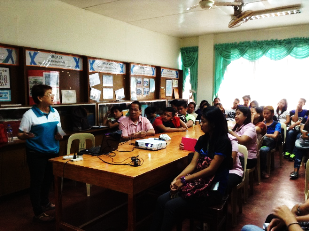 The Inland Aquatic Resources Research Division (IARRD) of the Philippine Council for Agriculture, Aquatic and Natural Resources Research and Development of the Department of Science and Technology (DOST-PCAARRD) recently monitored two projects on tilapia and mussel at the Mariano Marcos State University (MMSU) in Currimao, Ilocos Norte and in Cagayan State University (CSU) in Aparri, Cagayan.
The Inland Aquatic Resources Research Division (IARRD) of the Philippine Council for Agriculture, Aquatic and Natural Resources Research and Development of the Department of Science and Technology (DOST-PCAARRD) recently monitored two projects on tilapia and mussel at the Mariano Marcos State University (MMSU) in Currimao, Ilocos Norte and in Cagayan State University (CSU) in Aparri, Cagayan.
The visit aimed to assess the projects’ accomplishments; identify priority projects for 2017 in the region; present the Industry Strategic S&T Program (ISP) for inland aquatic resources; and encourage other R&D stakeholders to get involved in the Council’s banner programs.
“Regional priorities like goby fishery, seaweeds, bivalves, and abalone should be given attention,” said MMSU Currimao Campus Director Dr. Andres Y. Tungpalan, after IARRD Director Dr. Dalisay DG. Fernandez presented the ISP for Inland Aquatic Resources.
The group visited the Provincial Satellite Fish Farm in Saludares, Dingras, Ilocos Norte, wherein 10 hapa nets are installed and fish stocking is in progress. The fish farm is still using the traditional culture practice, which produces 450,000 tilapia fingerlings that are distributed to fisherfolks all year round for free. The number of fingerlings is expected to increase once the aquashade is implemented. According to MMSU’s Tilapia Study Leader, Dr. Veronica O. Grande, the aquashade for tilapia culture was already fabricated.
Meanwhile, the mussel project at CSU in Aparri, Cagayan, has already established spat collectors in three target sites, which include the Cagayan River Estuary, Buguey Lagoon in Gonzaga, and Sta. Ana, Cagayan. Currently, the project team is exploring the potential of mussel wild stocks for transplantation aside from the hatchery-bred stocks coming from the University of the Philippines Visayas (UPV). Spat collectors and longline units are currently being prepared for installation.
To ensure the smooth implementation of the project, the CSU project team established linkages with the Bureau of Fisheries and Aquatic Resources (BFAR) regional office and sub-stations, local government units (LGUs) including municipal mayors and municipal agriculturists, and the Philippine Coast Guard.
Potential collaboration was also discussed with the BFAR Planning, Monitoring, and Evaluation Division Head Dr. Angel Encarnacion and BFAR RO2 Fisheries Production Division Head Dr. Severina Bueno. They also identified ludong and other mullet species, eel, seaweed, and freshwater shellfishes like unok and kabibi as regional priority commodities. According to Encarnacion and Bueno, glass eels or juvenile eels are targeted by smugglers for export to Taiwan and Japan for its culture potentials.
Possible projects identified for S&T interventions to be submitted by CSU and BFAR RO2 were: Upgrading of Multi-species Hatchery and Shellfish Quarantine Facilities, Saline Tilapia R&D Program, Pilot Testing of Red Tilapia Farming, Sustainable Eel Production Program, Sustainable Freshwater Shellfish Program, and Capability Training on Proposal Packaging for Aquatic Resources Research.
